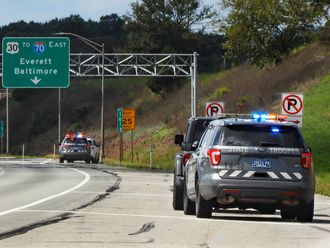
Chilmark, Massachusetts: Once a month, on a street of picture-perfect clapboard houses, white picket fences and fluttering American flags, families gather in this wealthy Massachusetts enclave for a lifeline.
They walk through an unmarked door and into a musty communal space with a stained beige carpet and ageing furniture. Beyond is a small room piled high with boxes. Crates of microwave popcorn, spaghetti and cans of beans line one wall beside two freezers filled with meat, and boxes of potatoes and squash litter the floor.
For an hour on these Friday afternoons, dozens of families sit patiently beneath a painting of Jesus as volunteers check their details and hand out three precious brown bags of food.
The building in Vineyard Haven is a food bank, one of two on Martha’s Vineyard — an island better known as a playground for presidents and playboys.
President Barack Obama’s vacation here ends on Sunday, after which he’ll resume his push to secure “a better bargain for the middle class” by embarking on a two-day bus tour of New York and Pennsylvania. In hard-hit places such as Scranton, Pennsylvania, and Buffalo, New York, he’ll press his point that widening income inequality has frayed the social fabric of the country.
But the place he’s leaving is no exception to that fraying. Though presidential photo-ops don’t show it, the island is actually a place where the wealth gap is starker than almost anywhere else in the United States, year-round residents say, and middle-class hopes and dreams are drifting out of reach.
James Streicher Evans, a slight and soft-spoken 26-year-old with a college education, earns $20 (Dh73.4) an hour landscaping the manicured estates of the super-wealthy.
And then, in the winter, he signs up for unemployment benefits and waits for spring. He said he has little opportunity to find a year-round job or build up savings, and even less prospect of buying a house.
For him, like many islanders, the middle-class dream of being able to work hard and get ahead is an impossible one.
The average wage on Martha’s Vineyard is 71 per cent of the state average, according to a recent government report on the island’s housing needs. By contrast, rental prices are 17 per cent higher and house prices are 54 per cent above average.
“We’re losing our middle class and we’re losing our young people because the jobs aren’t there and because of the cost of living and housing,” said Peter Temple, a retired businessman who serves as executive director of Martha’s Vineyard Donors Collaborative, which encourages island philanthropy.
“The few job opportunities that exist on the island — in construction, retail and the service industries — are dependent on the area’s wealthy visitors and provide work for only a few months of the year,” Evans explained.
Betty Burton is a 64-year-old librarian who is also responsible for running the island’s two food banks.
A resolute woman with light brown curly hair and a colourful necklace, Burton said demand has soared since the housing bubble burst and the country plunged into recession in 2008.
Construction projects stopped overnight, visitors stopped eating out and even the super-wealthy cut back on remodelling their estates, she said.
“Construction companies were doing jobs at cost just to keep employees going,” she said.
Rather than operating only in winter, the food bank became a year-round service.
Those who qualify receive three bags filled with vegetables, canned goods, rice, pasta and any excess produce from “gleanings” at local farms.
“I can’t tell you how many of my friends have left the island because they can no longer afford to live here,” she said, describing them as having “slipped out of the middle class.”
Temple said an estimated 1,000 people who use the other food bank on Martha’s Vineyard - the Island Food Pantry — have similar stories.
“The families that go are policemen and teachers and people who we need to sustain the island,” he said. “It’s people who would make a decent salary on the mainland, but they find it real tough here.”
A recent official count registered 120 homeless people on the island. But Burton said the summer residents - sometimes referred to with derision as “August people” — who inhabit the island’s tennis courts and yacht clubs often have no idea that there is poverty on the island, although they can be relied upon to contribute to “big-ticket items.” The island’s state-of-the-art hospital on the outskirts of Vineyard Haven, which opened in 2010, was built with more than $50 million in donations.
“You can go down a dirt road and see Obama, or you can go down a dirt road and see a shack,” she said. “It’s hidden away.”
Sitting at a coffee shop on the main road in Vineyard Haven on a recent evening, Dan Waters, a local artist and poet who works at the Martha’s Vineyard Museum as a fund-raiser, reflected on the daily reminders of the striking contrast in wealth between the haves and have-nots.
He recounted a visit to a house “that must have been 20,000 square feet.”
It had “a living room that had 40-foot ceilings and a swimming pool that you could have floated a small yacht in,” he said.
“At one point I asked if there was a bathroom in the basement - we were touring the place - and the owner said she couldn’t remember. I was agog.”
Others pointed to the absurdity of living on an island where hundreds are reliant on food banks while the price of a key that accesses a private beach for three months of the year has reached as much as half a million dollars.
For those prepared to weather the summer “dash for cash,” winter brings a unique sense of community.
“We have potluck jams. People bring food and musicians play for free, and there’s no charge at all - it’s a celebration of being an artist, being out of work, being winter time,” Waters said.
“We take care of each other,” said Michele Anne Jones, a 66-year-old music teacher who brought up five children on the island, largely as a single parent.
“When the children were little, there was a big network of mothers and hand-me-downs as far as bicycles and clothes and things that were needed.”
But ultimately, many longtime residents think that the year-round population that has resided in the island’s old whaling towns for generations has been dealt a fatal blow.
“A lot of people who have been here a long time lament the fact that people who have been part of the fabric of the community can’t afford to live here anymore and have to leave,” Temple said.
Waters is blunter.
“I think in 30 years, you won’t see a generation like mine who have known people for 30 years and grew up with them.
“I think that will have disappeared.”












